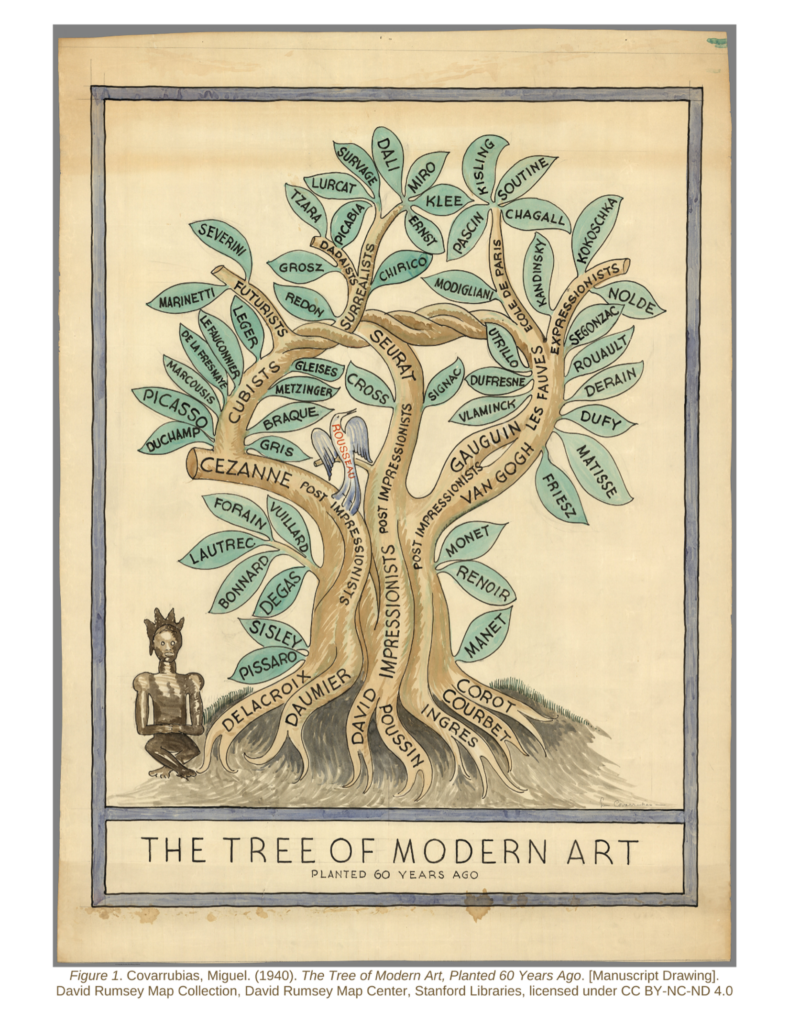Greetings from Vidhya Shanker, convener of The May 13 Group.
Art history taught me to ask why makers choose some forms and not others.
In his video echoing the idea that Nicky Bowman, Jara Dean-Coffey, and myself have shared—to use a forest ecosystem instead of a single tree as a metaphor for the knowledge economy that evaluation co-constitutes—Michael Quinn Patton asks Evaluation Roots editor Christina Christie about her and Marv Alkin’s inspiration for the Evaluation Theory Tree that so many instructors use to socialize emerging evaluators into the field.
!["We were working with an art history student and we took a look at a painting—a very well-known painting—called Modern Art in America. And if you take a look at that visual image, it's a tree. And there are these leaves, and it's very intricate. And what you see are…the influence of these great painters—these great artists—and then how they influence other people's work…. [We] thought this could potentially be a very thoughtful way to visually depict the relationship between the work of evaluation scholars, in particular those who write about evaluation theory—and again, these are theories of practice—and to show their relationships and to show some historical evolution, but not in a very traditional flowchart. Kind of in a way that was flexible, more fluid, and that would allow a visual representation of those relationships." Quote from Christina Christie](https://aea365.org/blog/wp-content/uploads/2024/02/Christie-2023-Quote.png)
Look carefully at the image (below) that Christie responds was their inspiration.

What do we see and what don’t we see?
The tree that Christie named as having inspired the Evaluation Theory Tree has seven roots labeled with artists credited with setting the foundation for art called “modern.” Its trunk and branches bear the names of artists and art movements. Each leaf bears an artist’s name. The art movements named are all European. Nearly all the artists are French White men. At the base of the tree is a stylized figure, unlabeled, to be read—presumably—as African. Under the caption “The Tree of Modern Art” is the subcaption “Planted 60 Years Ago.”
Who planted the tree?
The tree that inspired Alkin and Christie was drawn in 1940 by Miguel Covarrubias, a caricaturist and satirical illustrator, among many other things. Born in Mexico City to petit-bourgeois parents of European and Mexican ancestry and raised during the Mexican Revolution, he did not go to art school. Upon graduating, he drew maps for his dad and moved to New York City, where he enjoyed the Harlem Renaissance and befriended its artists. Covarrubias is also known for his study of Olmec and Asian cultures and his collection of pre-Columbian and Asian art.
The tree Christie references was a copy Covarrubias made for a friend rather than on commission or for public consumption. His original illustration has a similarly stylized (fetishized?) “African” figure at the left base of the tree. However, it also has a stylized sculpture of a white (marble?) head—presumably Greco-Roman or (Neo)classical. Additionally, a formally-dressed White man reclines at the right base of the original tree. While unnamed, the man would have been recognized by intended viewers as Dr. Alfred Barr, Jr., an American art historian and founding director of the Museum of Modern Art (MoMA), which Abby Rockefeller helped found days after the Crash of ‘29.
Why did they plant the tree?
The original illustrated an article entitled “The Tree of Modern Art: A Simplified Guide To The Modern Movement—For The Uninitiated,” by British painter, art historian, and critic R. H. Wilenski in the May 1933 issue of Vanity Fair. It was commissioned by Frank Crowninshield, who had been invited by elite-publication owner Condé Nast, his long-time friend, to edit Vanity Fair. Crowinshield was a founding trustee of MoMA, and the magazine’s next several issues included color reproductions of works by artists on Covarrubias’s tree, with biographical and critical notes, and the tree itself. Covarrubias’s illustration was not commissioned to be a scholarly representation of modern art’s history but rather a primer to cultivate modern art enthusiasts and MoMA patrons during the Great Depression.
Artmaking, like art history, as critical praxis
How does this understanding of the Modern Art Tree affect how you see—how you look at—the Evaluation Theory Tree?
- What practical and ideological purposes did the Modern Art Tree serve? The Evaluation Theory Tree? What assumptions does each reveal about who produces and influences art/knowledge, how, and why?
- Being so familiar—close—with modern artists outside Europe/ European ancestry, why did Covarrubias name only European White men?
- Why did the mestizo satirist draw the objects that he did and place them where he did relative to the tree? What might he draw at the bottom left of the Evaluation Theory Tree? Who might he draw reclining at the bottom right?
- What does Covarrubias’s illustration say about time, geography, and (mis)appropriation? How do these facets of modernism show up in evaluation’s Theory Tree? Literature? Practice?
The American Evaluation Association is hosting Arts, Culture, and Museums (ACM) TIG Week. The contributions all week come from ACM TIG members. Do you have questions, concerns, kudos, or content to extend this AEA365 contribution? Please add them in the comments section for this post on the AEA365 webpage so that we may enrich our community of practice. Would you like to submit an AEA365 Tip? Please send a note of interest to AEA365@eval.org. AEA365 is sponsored by the American Evaluation Association and provides a Tip-a-Day by and for evaluators. The views and opinions expressed on the AEA365 blog are solely those of the original authors and other contributors. These views and opinions do not necessarily represent those of the American Evaluation Association, and/or any/all contributors to this site.
